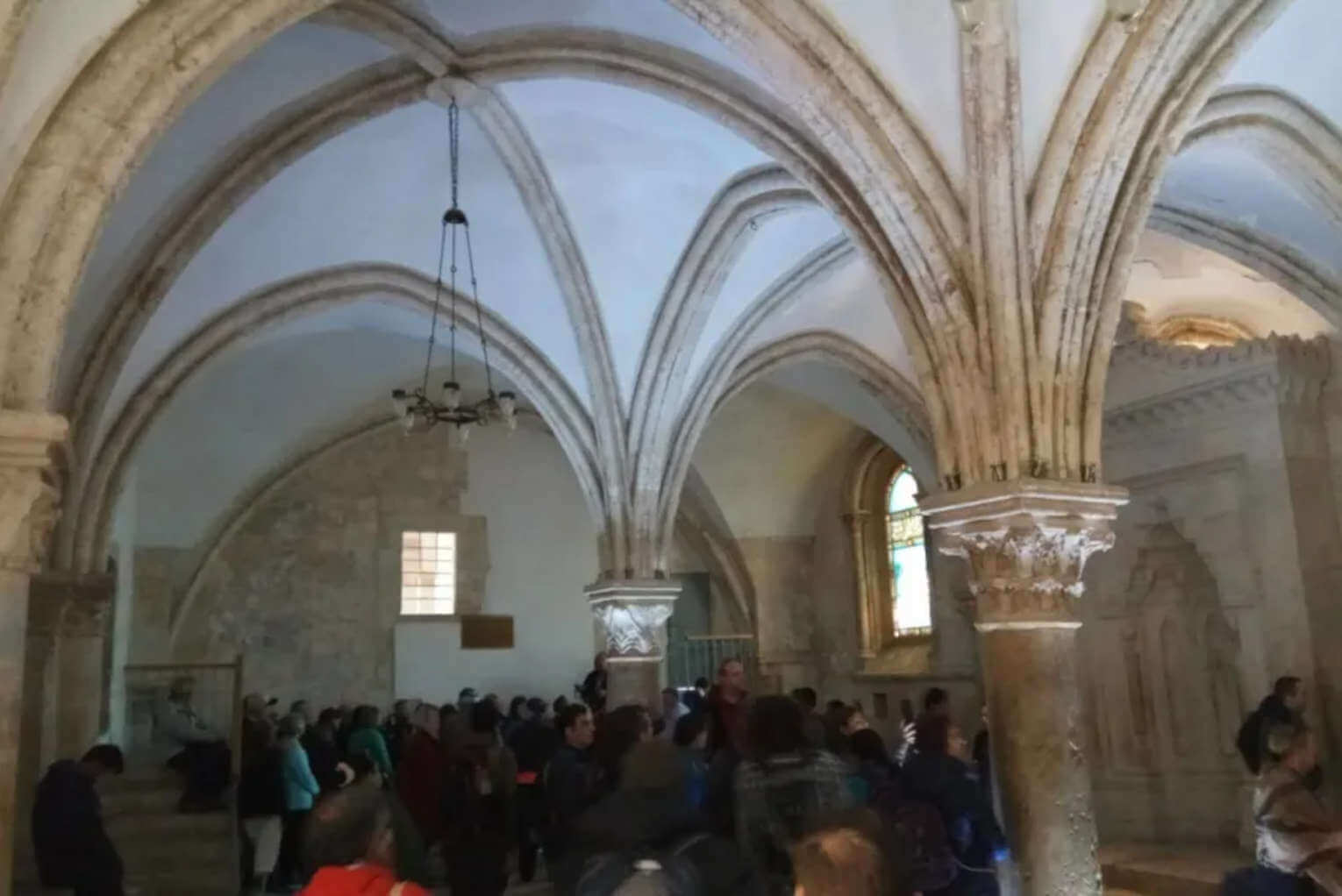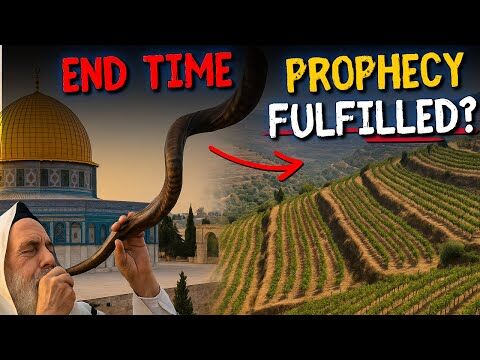The Upper Room, also called the Cenacle, is the site in Jerusalem traditionally identified as the location of the Last Supper, where Jesus dined with his apostles.
It also served as a meeting place for the apostles post-ascension and during Pentecost. While debate surrounds its origins and authenticity, archaeological findings and ancient sources suggest its veneration dates back to the early Christian era.
The term “Cenacle” comes from the Latin word for dining room, while “Upper Room” is derived from Greek terms used in the Gospels.
The Cenacle is located in a building managed today by Israeli authorities, which also contains the traditional location of King David’s Tomb on the lower level of the building.
The Upper Room in Jerusalem holds special significance for all Christians and Messianic Jews, particularly during the feasts of Shavuot and Pentecost, which share the same historical roots.
For Jews, Shavuot celebrates the giving of the Torah while, for Christians, Pentecost, falling on the same day, marks the descent of the Holy Spirit on the apostles in the Upper Room. This event symbolizes the birth of the Christian Church.
Some Christian scholars suggest that the events on Mount Sinai, where Moses received the Torah and 3,000 Israelites died due to the incident of the Golden Calf, foreshadowed a greater event: The receiving of the Holy Spirit and God’s word on Mount Zion, where 3,000 were saved.
The site is located outside the current Ottoman 16th-century walls but was within the city boundaries during Jesus’ time.
Breaking News. Spirit-Filled Stories. Subscribe to Charisma on YouTube now!
It was most probably part of the Essenes’ Quarter in Jerusalem, as Flavius Josephus mentions the nearby “Gate of the Essenes” in his writings. Other sources support this as well. This part of Jerusalem was, in any case, located on the upper area of the city’s Western hill.
The Cenacle is linked to several key New Testament events, including Jesus preparing for Passover, celebrating the Passover, washing his disciples’ feet, and appearing to them after his resurrection. It’s also where the apostles chose Matthias as Judas’ replacement and received the Holy Spirit on Pentecost.
It may, in fact, be the place where the apostles continued to meet in Jerusalem for a very long time, and where the church of Jerusalem was located until the rise of Byzantine Christian rule.
The current Gothic structure, dating from the 13th to 14th century, has undergone multiple reconstructions over the centuries. However, a majority of scholars agree that the location of the original room is indeed the same spot.
Over time, the Cenacle has seen various phases. It officially became a Christian site under Byzantine rule, was later transformed during the Crusades, and then converted into a mosque under Ottoman rule. The Franciscans managed the site from the 14th to 16th century, until they were evicted.
Today, there is debate about the interpretation of the origins of the place, its identification, authenticity, and location.
Historically, the site has been a place of significance for Christians since the 4th century A.D., and even before. We know that in the 4th century, a large church called “Hagia-Sion” was built at this very spot, next to the Upper Room.
The 4th-century Church of Santa Pudenziana in Rome displays a beautiful wall mosaic of Jerusalem, depicting the church of Hagia-Sion.
Originally the church was an octagonal commemorative building before being renovated as a long rectangular basilica. The mosaic of Santa Pudenziana depicts the church in its first octagonal stage, and there appears to be a square-shaped building to the right of it.
The depiction, like all other maps of antiquity, is “oriented,” meaning it looks to the East, and the square room should be located to the south of the octagonal church. This correlates with the archaeological remains found on Mount Zion today.
Another mosaic depiction of the church, this time showing its renovated state as a long basilica but still with the square building to its left, was discovered in an ancient 6th-century Byzantine church at Madaba (modern Jordan).
The mosaic is a map correctly showing the church in the southern part of the city. Almost all scholars identify the church’s depiction with the Hagia-Sion church.
All these elements taken together don’t leave any doubt that the upper room, shown as a special square-shaped building next to the commemorating church, was already venerated very early, during the 4th century A.D. and forward, at this place.
Many archaeologists interpret the square building as a venerated part of the church, while some scholars suggest it was originally a synagogue, and others see it as a church-synagogue of early Christians with Jewish roots. If this is accurate, the veneration of this place as the Upper Room may even have begun before the 4th century A.D.
The early church fathers of the church also mention the Upper Room, and even a synagogue, or a “church built by Jews” at this spot: Epiphanius, Eusebius, and even the Pilgrim of Bordeaux in the 4th century all provide precious details that leave no doubts about the correct identification.
Pinkerfeld, an archaeologist who dug there at the beginning of the 20th century, revealed plastered wall remains with ancient graffiti mentioning Jesus and early Christian prayers while identifying the site as an ancient Synagogue. Many, therefore, have interpreted the site as a church-synagogue and even a very early Christian church led by the Jewish community that followed Jesus’ teachings.
Many archaeologists are dating the first layers of the walls to the remains of a 1st or 2nd-century church led by this community.
In addition, the Israeli archaeologist Amit Reem who recently led basic excavations at the site of King David’s tomb mentioned that architectural remains and debris of a 1st-century monumental or public building were discovered, pre-dating the Byzantine Hagia-Sion 4th-century A.D. church that was built next to the “square shaped” enigmatic house.
The site holds a niche, under the Upper Room and inside the traditional King’s David tomb, sometimes interpreted as the remains of the Byzantine church apses or as an apse of the early church-synagogue. The apse is facing to the north, and not exactly to the northeast, the direction of the Temple, as it should be for a Jewish synagogue. It also doesn’t face toward the east as a Byzantine church should. This led many to interpret this apse as belonging to the early church-synagogue that may have been there and facing the direction of the Golgotha to the north.
It is clear that the current configuration of the Upper Room is not the original one. However, the early building that stood there during the 1st or 2nd century A.D., as well as the Byzantine churches that were later destroyed, all marked the remembered location.
Thus, the present medieval building is very likely situated in the exact same spot.
Today’s structure features a mix of architectural styles from different periods, with some elements dating back to the 12th century. The Cenacle contains several notable features, such as rib-vaulted bays and diverse column capitals that hint at its complex history.
Joel P. Kramer’s popular archaeological book offers a unique perspective on the Upper Room, utilizing ancient literature and archaeological evidence to provide a profound interpretation of its significance. It’s a must-read for anyone interested in biblical archaeology, offering insights into the authenticity of the site.
It’s worth noting that some propose the Monastery of Saint Mark in Jerusalem as an alternative site for the Last Supper. However, the majority of scholars argue that both archaeology and ancient sources are less supportive of this location.
This article originally appeared on ALL ISRAEL NEWS, and is reposted with permission.
Aaron Goel-Angot is a Belgian-Israeli archaeologist with an expertise in antiquities identification. He is an enthusiastic numismatist and a licensed tour guide. He holds a BA degree in archaeology from the Institute of Archaeology at the Hebrew University of Jerusalem. He joined the ALL ISRAEL NEWS team as an Archaeology and Tourism correspondent. Aaron is married, father of three young children and lives in Jerusalem.
Join Charisma Magazine Online to follow everything the Holy Spirit is doing around the world!












































